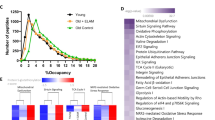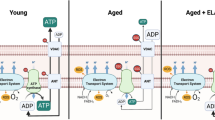Abstract
We analyzed the effects of aging on protein abundance and acetylation, as well as the ability of the mitochondrial-targeted drugs elamipretide (SS-31) and nicotinamide mononucleotide (NMN) to reverse aging-associated changes in mouse hearts. Both drugs had a modest effect on restoring the abundance and acetylation of proteins that are altered with age, while also inducing additional changes. Age-related increases in protein acetylation were predominantly in mitochondrial pathways such as mitochondrial dysfunction, oxidative phosphorylation, and TCA cycle signaling. We further assessed how these age-related changes associated with diastolic function (Ea/Aa) and systolic function (fractional shortening under higher workload) measurements from echocardiography. These results identify a subset of protein abundance and acetylation changes in muscle, mitochondrial, and structural proteins that appear to be essential in regulating diastolic function in old hearts.



Similar content being viewed by others
References
Baeza J, Smallegan MJ, Denu JM. Site-specific reactivity of nonenzymatic lysine acetylation. ACS Chem Biol. 2015;10(1):122–8. https://doi.org/10.1021/cb500848p.
Chiao YA, Zhang H, Sweetwyne M, Whitson J, Ting YS, Basisty N, Pino LK, Quarles E, Nguyen NH, Campbell MD, Zhang T, Gaffrey MJ, Merrihew G, Wang L, Yue Y, Duan D, Granzier HL, Szeto HH, Qian WJ, … Rabinovitch P. Late-life restoration of mitochondrial function reverses cardiac dysfunction in old mice. Elife. 2020;9:1–26. https://doi.org/10.7554/eLife.55513.
Dai D-F, Chen T, Johnson SC, Szeto H, Rabinovitch PS. Cardiac aging: from molecular mechanisms to significance in human health and disease. Antioxid Redox Signal. 2012;16(12):1492–526. https://doi.org/10.1089/ars.2011.4179.
Grant JE, Bradshaw AD, Schwacke JH, Baicu CF, Zile MR, Schey KL. Quantification of protein expression changes in the aging left ventricle of Rattus norvegicus. J Proteome Res. 2009;8(9):4252–63. https://doi.org/10.1021/pr900297f.
Krämer A, Green J, Pollard J, Tugendreich S. Causal analysis approaches in Ingenuity Pathway Analysis. Bioinformatics. 2014;30(4):523. https://doi.org/10.1093/BIOINFORMATICS/BTT703.
Lee CF, Chavez JD, Garcia-Menendez L, Choi Y, Roe ND, Chiao YA, Edgar JS, Goo YA, Goodlett DR, Bruce JE, Tian R. Normalization of NAD+ redox balance as a therapy for heart failure. Circulation. 2016;134(12):883–94. https://doi.org/10.1161/CIRCULATIONAHA.116.022495.
Leek JT, Storey JD. Capturing heterogeneity in gene expression studies by surrogate variable analysis. PLoS Genet. 2007;3(9):1724–35. https://doi.org/10.1371/journal.pgen.0030161.
Liu L, Su X, Quinn WJ, Hui S, Krukenberg K, Frederick DW, Redpath P, Zhan L, Chellappa K, White E, Migaud M, Mitchison TJ, Baur JA, Rabinowitz JD. Quantitative analysis of NAD synthesis-breakdown fluxes. Cell Metab. 2018;27(5):1067-1080.e5. https://doi.org/10.1016/j.cmet.2018.03.018.
Mills KF, Yoshida S, Stein LR, Grozio A, Kubota S, Sasaki Y, Redpath P, Migaud ME, Apte RS, Uchida K, Yoshino J, Imai S. Long-term administration of nicotinamide mononucleotide mitigates age-associated physiological decline in mice. Cell Metab. 2016;24(6):795–806. https://doi.org/10.1016/j.cmet.2016.09.013.
Morimoto RI, Cuervo AM. Proteostasis and the aging proteome in health and disease. J Gerontol A Biol Sci Med Sci. 2014;69(Suppl 1):S33-8. https://doi.org/10.1093/gerona/glu049.
Quarles E, Basisty N, Chiao YA, Merrihew G, Gu H, Sweetwyne MT, Fredrickson J, Nguyen NH, Razumova M, Kooiker K, Moussavi-Harami F, Regnier M, Quarles C, MacCoss M, Rabinovitch PS. Rapamycin persistently improves cardiac function in aged, male and female mice, even following cessation of treatment. Aging Cell. 2020;19(2). https://doi.org/10.1111/acel.13086.
Ritchie ME, Phipson B, Wu D, Hu Y, Law CW, Shi W, Smyth GK. Limma powers differential expression analyses for RNA-sequencing and microarray studies. Nucleic Acids Res. 2015;43(7): e47. https://doi.org/10.1093/nar/gkv007.
Santos AL, Lindner AB. Protein posttranslational modifications: roles in aging and age-related disease. Oxid Med Cell Longev. 2017;2017:5716409. https://doi.org/10.1155/2017/5716409.
Searle BC, Pino LK, Egertson JD, Ting YS, Lawrence RT, MacLean BX, Villén J, MacCoss MJ. Chromatogram libraries improve peptide detection and quantification by data independent acquisition mass spectrometry. Nat Commun. 2018;9(1). https://doi.org/10.1038/s41467-018-07454-w.
Thomas DA, Stauffer C, Zhao K, Yang H, Sharma VK, Szeto HH, Suthanthiran M. Mitochondrial targeting with antioxidant peptide SS-31 prevents mitochondrial depolarization, reduces islet cell apoptosis, increases islet cell yield, and improves posttransplantation function. J Am Soc Nephrol. 2007;18(1):213–22. https://doi.org/10.1681/ASN.2006080825.
Walther DM, Kasturi P, Mann M, Ulrich F, Correspondence H. Widespread proteome remodeling and aggregation in aging C. elegans. 2015. https://doi.org/10.1016/j.cell.2015.03.032.
Wei R, Wang J, Su M, Jia E, Chen S, Chen T, Ni Y. Missing value imputation approach for mass spectrometry-based metabolomics data. Sci Rep. 2018;8(1). https://doi.org/10.1038/s41598-017-19120-0.
Whitson JA, Bitto A, Zhang H, Sweetwyne MT, Coig R, Bhayana S, Shankland EG, Wang L, Bammler TK, Mills KF, Imai S, Conley KE, Marcinek DJ, Rabinovitch PS. SS-31 and NMN: two paths to improve metabolism and function in aged hearts. Aging Cell. 2020. https://doi.org/10.1111/acel.13213.
Whitson JA, Martín-Pérez M, Zhang T, Gaffrey MJ, Merrihew GE, Huang E, White CC, Kavanagh TJ, Qian W-J, Campbell MD, MacCoss MJ, Marcinek DJ, Villén J, Rabinovitch PS. Elamipretide (SS-31) treatment attenuates age-associated post-translational modifications of heart proteins. GeroScience. 2021. https://doi.org/10.1007/s11357-021-00447-6.
Yeo D, Kang C, Ji LL. Aging alters acetylation status in skeletal and cardiac muscles. GeroScience. 2020;42(3):963–76. https://doi.org/10.1007/s11357-020-00171-7.
Funding
Funding for this research was provided by NIH grants T32AG000057, P01AG001751, the UW Nathan Shock Center, P30 AG013280, and AHA 19CDA34660311. Elamipretide was kindly provided by Stealth Therapeutics (Needham, MA). Stealth BioTherapeutics did not play any role in the experimental design, data collection, or authorship of this work. The laboratory of James Bruce kindly provided DDA data on heart peptide acetylation for the purposes of building a peptide library [6].
Author information
Authors and Affiliations
Corresponding author
Ethics declarations
Conflict of interest
The authors declare no competing interests.
Additional information
Publisher's Note
Springer Nature remains neutral with regard to jurisdictional claims in published maps and institutional affiliations.
Supplementary Information
Below is the link to the electronic supplementary material.
About this article
Cite this article
Whitson, J.A., Johnson, R., Wang, L. et al. Age-related disruption of the proteome and acetylome in mouse hearts is associated with loss of function and attenuated by elamipretide (SS-31) and nicotinamide mononucleotide (NMN) treatment. GeroScience 44, 1621–1639 (2022). https://doi.org/10.1007/s11357-022-00564-w
Received:
Accepted:
Published:
Issue Date:
DOI: https://doi.org/10.1007/s11357-022-00564-w




